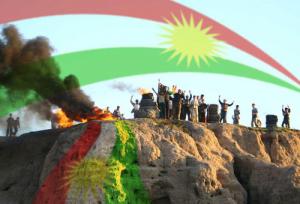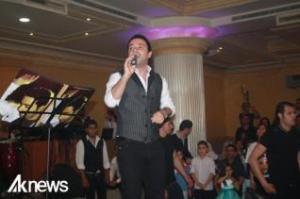
A Kurdish Outlook on Newroz

By ROZH AHMAD-Rudaw
LEEDS, United Kingdom -- The Newroz celebration, taking place on March 21, is New Year according to the Kurdish Calendar. It is the same for many nationalities and communities around the world whose indigenous calendar is derived from the ancient Zoroastrian calendar.
According to historians, Zoroastrianism is the oldest religion and philosophy that existed in Mesopotamia. It was the first religion in early human civilization, when the Silk Road adjoined the ancient world together. Perhaps this is why Newroz is celebrated so widely across the globe.
Every year, Kurds and non-Kurds celebrate the Zoroastrian New Year in various communities all over the Middle East, North Africa, Central Asia and across the Caucasus.
The historical understanding of Newroz is that March 21 coincides with the March equinox and is a holy day among the green-loving Zoroastrians. Fire is another sacred symbol in the religion, and Zoroastrians in ancient Mesopotamia welcomed spring by setting bonfires on mountain peaks, symbolizing a declaration of faith and their core values of “good thoughts, good words and good deeds.”
Newroz today is celebrated by those whose ancestors were once governed by the Kurdish Median Kingdom and the Iranian Persian Empire, where Zoroastrianism was the official religion.
“Newroz today is celebrated by those whose ancestors were once governed by the Kurdish Median Kingdom and the Iranian Persian Empire,”
For many people and members of the Zoroastrian community, wherever they may be, Newroz means welcoming the beauty of spring, and celebrating diversity and peaceful coexistence. It is when people forgive one another in order to open a new chapter in their life.
The festivity’s ambiance and emphasis on family gatherings and togetherness are similar to other global celebrations such as Christianity’s Christmas and Islamic Eid. There is even a Father Christmas-like figure involved in Newroz celebrations, particularly in Iranian Kurdistan. He is called “Father Newroz,” an elderly man whose sole job is to bring joy and happiness to poor children every March 21.
While the celebration is similar to many religious and cultural festivities taking place in the modern world, there is a point of difference in how Kurdish people celebrate Newroz. Kurds perceive themselves as descendants of the ancient Medes of Mesopotamia, and are also the only nation in the world to politically define the event. Celebrating Newroz is insisted upon more among Kurds, and is a more widespread event in Kurdistan than anywhere else.
The Kurdish folklore tale of Newroz is the same as what my grandmother told me. Once upon a time, the people of Mesopotamia were subjected to brutal repression by a king known as Zwhak; he was allegedly Iranian of Persian origin. He oppressed the population of Kurdish Medes in Mesopotamia. King Zwhak had two undying, bloodthirsty snakes on his shoulders and Kurdish youths were killed in order for those snakes to drink their blood. The victims included four sons of a Kurdish blacksmith, Kawa, who is renowned for his bravery in Kurdish literature and often described as “legendary Kawa the blacksmith.”
Having witnessed his sons’ deaths at the hands of the infamous henchmen belonging to King Zwhak, Kawa organized a revolution and led the Kurdish people of Mesopotamia to overthrow the notorious emperor.
My grandmother used to tell me that it was on March 21 that Kawa killed King Zwhak with his hammer and announced the free state of the oppressed people of Mesopotamia. Apparently, the big bonfires burned on the mountain peaks of Kurdistan at the time signified victory over the bloodthirsty Persian King Zwhak.
Just as my grandmother insisted that Kawa was Kurdish and of Medes origin, different nations’ accounts of Newroz also claim the brave rescuer came from their community, though their hero may hold a different identity than that of the Kurdish blacksmith legendary hero.
As far as the truth is concerned, Kurdish people established one of the very first civilizations with the people of Mesopotamia; today, they make up the largest nation on the planet deprived of the basic democratic right to choose their own fate and elect a state of their own.
For the estimated 40 million Kurds currently divided over modern Iraq, Iran, Turkey and Syria, whose basic democratic rights have been undermined on the rubble of their ancient kingdom, Newroz is a festivity that defines their political identity.
“In the eyes of the people of Kurdistan, Newroz is a lot more than celebrating a cultural phenomenon or admiring the “good old values” of ancient Zoroastrianism.”
In the eyes of the people of Kurdistan, Newroz is a lot more than celebrating a cultural phenomenon or admiring the “good old values” of ancient Zoroastrianism. For Kurds, Newroz signifies unity and brotherhood for national liberation, emancipation and empowerment of the oppressed. It has become an annual event registered in every Kurd’s memory to further their salvation and independence in a political sense.
Newroz provides this identity for modern Kurds as a result of the status quo of being Kurdish in the modern Middle East. It defines emancipation and liberation due to the long fought for cause of Kurdish independence which, in effect, amongst other things, has politicized to the core many aspects of the Kurdish way of life, including this traditional New Year.
As early as the 1940s, the Kurdish intelligentsia, political activists and revolutionaries from across the political spectrum began working to revive Newroz celebrations with modern Kurdish characteristics. It was a strategy to resurrect national liberation consciousness among the Kurdish population. More central to their work was for Newroz to express the ultimate political will of modern Kurds, whose homeland by this time had been divided by Western imperialists for over two decades and at the same time occupied by neighboring countries.
What those Kurdish activists pursued was not a nationalist agenda, as many people outside Kurdistan would claim; it was rather a self-defence strategy. In Saddam Hussein’s Iraq, even the Communist Party used to organize Newroz festivities to challenge the state ban imposed on the entire Kurdish population by Hussein’s regime. It was to express the will of succession and formation of a united democratic republic of Kurdistan, highly popular among their Kurdish members who also advocated communist internationalism, not nationalism.
While state-racism and brutality at the hands of occupation forces had intensified against Kurds, often by Western-backed militarist regimes in the 1960s and onward, the very expression of being a Kurd in the modern Middle East had equally turned into a political expression. Apart from Iran, where the vast majority of the population recognizes Zoroastrianism as part of their ancient history, occupation forces in other parts of Kurdistan in Turkey, Syria and Iraq always imposed state-bans on Newroz celebrations.
Throughout the 20th century, despite the brutality of the occupation and the notorious ethnic cleansing military strategies by consecutive foreign autocratic regimes’ reign in Kurdistan, many Kurds, women and men alike, sacrificed their lives in order to continue celebrating Newroz as a traditional Kurdish festival.
Zaki Alkan, a Kurdish revolutionary who set herself ablaze and self-immolated to protest the state ban on Newroz by the Turkish government, is remembered today among Kurds for sacrificing her life for the cause of Newroz and Kurdish independence.
“For Kurdish youth in Turkey, innumerable soldiers marching up and down the streets signalled the coming of the New Year.”
For Kurdish youth in Turkey, innumerable soldiers marching up and down the streets signalled the coming of the New Year. While materials that looked like the colors of the Kurdish flag and PKK banners were waved on the ground, military checkpoints and mass arrests became a recurring feature that ended the New Year in unprovoked violence and conflicts usually triggered by Turkish military personnel.
March 21 in Turkey has always meant police brutality and suppression of Kurdish peaceful protesters. It became common for Kurdish youngsters to be shot dead in public places during clashes with police and security forces, especially when Kurdish youths tried defending their basic right to celebrate their nation’s New Year.
Years of unstoppable struggle by indigenous Kurds to celebrate this event as part of their basic democratic and cultural rights eventually had an impact on officials in Ankara. In 2000, Turkey changed its position and legalized the celebration, labelling it “Nevruz,” in Turkish spelling, and declaring it is a “Turkish people’s spring holiday.” In 2006, human rights violations were once again widespread against Kurdish participants in Newroz festivals across Turkey.
Currently, the situation is better than it used to be as the incumbent Justice and Development Party (AKP) government has begun to demilitarize parts of the Turkish political establishment.
The official Newroz festival in Turkey takes place in the heart of the Kurdish city of Diyarbakir, the unofficial capital of greater Kurdistan. It attracts millions. Kurdish locals, activists, artists, politicians, youth organizers and mothers of Kurdish martyrs, along with anyone who sympathizes with the cause, together declare their political identity and their will for an independent and united Kurdistan.
Newroz celebrations were also banned in Syria until very recently and people could only celebrate without mentioning any political elements surrounding the event, which is practically impossible given how politically charged Newroz is to modern Kurds.
Several Kurdish youngsters were shot dead by the Syrian police in 2008 after they set up a bonfire to mark Newroz. The Syrian police identified them as “political protests, anarchists aiming to overthrow the beloved president Assad and his government.”
According to human rights reports, while celebrating Newroz on March 21, 2010, Syrian security forces and police once again waged an attack on the Kurdish population in Raqa. It resulted in the killing of three youngsters, including a 15-year-old girl, and left 50 others wounded.
For modern Kurds, it is precisely such oppression that transformed Newroz into a focal point that today unites them to demonstrate an unbearable rage through peaceful protests, festivities and the celebration of cultural differences against countless years of national oppression and state-sponsored racism.
During acts of civil disobedience and in times of conflict, or whenever the state apparatus wants to prevent Newroz celebrations, Kurds have said “Bji Newroz” in greeting one another through difficult times, which literally means “Long Live Newroz.” One of the most common Newroz greetings in the Kurdish language is “Newroztan Piroz Bet,” which means, simply, “Happy Newroz to you all.”
- 10257 reads


